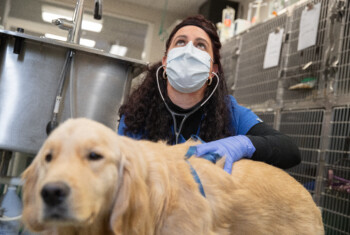Eye removal in pets.
When a chronic, painful disease, such as glaucoma or uveitis, causes irreversible blindness, surgery may be recommended to make your pet more comfortable.  One commonly performed technique is enucleation, or removal of the eye.
One commonly performed technique is enucleation, or removal of the eye.
Another option, which in many cases may provide a more cosmetic result, is an intrascleral prosthesis.
What is an intrascleral prosthesis?
An intrascleral prosthesis involves creating a large incision over the top of the eye underneath the upper eyelid, removing the contents of the eye, placing a silicone prosthesis inside the shell of the eye, and closing the incision.
With this procedure, the pet retains the shell of the eye. An analogy would be taking an orange, opening up the peel, removing all the fruit from inside and closing it back up again.
After the procedure, your pet will be on pain medications. There will also be a topical antibiotic/steroid ointment that will be applied to the eye several times a day.
Healing process.
The sight of an intrascleral prosthesis healing can be shocking if you do not know what to expect. Removing the contents of the eye takes away the supply of nutrition to the normally clear windshield of the eye, called the cornea.
In order to obtain nutrients, the cornea must now grow blood vessels over the next month or so, which appear as a red ring closing in on the central cornea.
Once the vessels have reached the middle of the cornea, they begin to regress, and the cornea will turn a grey to hazy black color.
Making the decision.
Not all dogs are candidates for this procedure. It should not be performed if the pet has significant corneal disease or if a tumor is suspected inside the eye.
Complications include corneal ulceration, decreased tear production, and, very rarely, rejection of the prosthesis.


